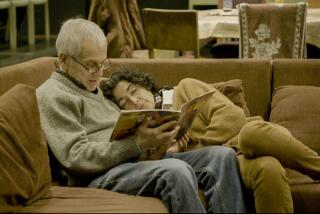Studying the Not-So-Sleepless in Italy
- Share via
Six months in Italy?
Sounds delightful.
Six months in Italy, chronicling the sleep patterns of old people?
It’s not on the itinerary for most travelers.
But Pat Riccio is no ordinary traveler.
Thanks to a Fulbright grant, she’ll be leaving her Oxnard beach house this summer to study sleep among Italian Alzheimer’s patients and the people who care for them.
This might sound like another headline in the annals of outrageous grantsmanship--”Scientist Gets Millions for Studying Butterfly Tongues!”--but it’s not.
Anyone who deals with Alzheimer’s patients knows how profoundly their flip-flopped sleep patterns can disrupt their lives and the lives of those around them.
“They get their days and nights confused,” said Charre Welch, director of nursing at Treacy Villa, an Alzheimer’s care facility in Ventura. “For some it’s not a problem, but for others, they’re in and out of bed all the time. Their brain is deteriorating; the only thing their bodies know is to walk . . . and walk . . . and walk.”
Interrupted sleep wears on people trying to care for their aging spouses or parents at home.
“Family members just can’t handle it anymore,” said Riccio, an assistant professor of nursing at USC. “It’s one of the biggest reasons patients are institutionalized. It’s difficult to deal with patients wandering around all night, poking their hands in your face when you’re trying to sleep, not to mention having the whacked-out behavior problems that go along with sleep disturbances.”
For reasons unknown, patients in Italy and their caregivers appear to be better off when it comes to sleep.
“The big difference seems to be less daytime sleepiness in the Italians,” said Riccio, who has collaborated on preliminary studies with researchers at the University of Rome. “I suspect it’s something cultural.”
Does the espresso have no effect? What about the nightly glass of vino rosso?
“These substances might be--I don’t know how else to say this--in the Italian blood,” said Riccio, who has quite a bit of Italian blood herself.
In Italy, Riccio will do further work on a theory she and a handful of other researchers around the world have been testing for years: The internal clocks of Alzheimer’s patients can be adjusted using carefully measured doses of bright light.
She has tried fitting Alzheimer’s patients with visors rigged with bulbs under the brim. She has designed “light rooms” so patients can get hours of steady, precisely calibrated exposure to the kind of brightness they might otherwise shun. For Riccio, the findings have been encouraging enough to keep the idea alive.
“As we age, people have a tendency to avoid bright light,” she said, “and, for some reason, Alzheimer’s patients tend to retreat even more. The very thing they need is what they avoid.”
If Riccio and her fellow researchers are right, more light in their lives will keep Alzheimer’s patients at home longer and help those in institutions get more rest.
That would be great news for the elderly, but it wouldn’t quell the fears of us boomers, who like to think we’ll handle old age with verve, energy and absolute control.
At 50, Riccio can’t go to a party or meet friends for dinner without fielding the inevitable half-joking, nervous questions:
“I can’t seem to remember names the way I once did. Should I worry?”
“At a meeting, it took me 30 seconds to grope for the right word. Should I worry?”
“I keep forgetting my car keys. Should I worry?”
No, no, no, Riccio says.
“Alzheimer’s isn’t forgetting your keys,” she tells her friends. “It’s forgetting how to drive.”
*
Steve Chawkins can be reached at 653-7561 or by e-mail at steve.chawkins@latimes.com.
More to Read
Sign up for The Wild
We’ll help you find the best places to hike, bike and run, as well as the perfect silent spots for meditation and yoga.
You may occasionally receive promotional content from the Los Angeles Times.







